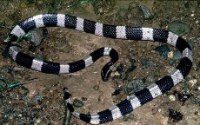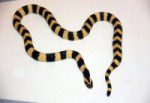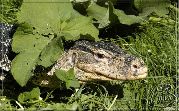
Krayt tape
This snake is widespread in India, Burma, the countries of Southeast Asia, on the Sunda Islands. Prefers both moderately wet and dry areas. For habitation, it chooses territories with various shelters, near which it hunts. It happens that the krait sneaks into human housing. The peak of activity of this snake falls on twilight and night, while in the daytime the snake hides in shelters.
The ribbon krait is the most common type of krait genus, which is also called pama. This is not a very large snake – the average length of an adult ribbon krait varies from 1,5 to 2 m. The slender and long body of the snake ends in a short tail, the head is rounded and does not stand out from the neck.
Classification.

Kingdom: Animalia (animals)
Type: Chordata
Class: Reptilia (reptiles)
Order: Squamata (scaly)
Suborder: Serpentes (snakes)
Family: Elipidae (aspididae)
Genus: Bungarus (kraits)
Species: Bungarus fasciatus (ribbon krait)
habitation.
The ribbon krait inhabits Northeast India, South China, Burma, the countries of Southeast Asia, the Sunda Islands. It lives in both moderately wet and dry places. However, a prerequisite for habitation is the presence of various shelters – burrows, shrubs, deadwood, near which the krait hunts. Krayt can also be found on cultivated lands, in yards and houses. In overpopulated areas, they are rarely found, although they can make their way into human habitation. Despite the fact that the ribbon krait has a round pupil, during the daytime the snake most often avoids the sun, hiding in its shelters.
Food.
The diet of the ribbon krait consists of lizards, snakes, small mammals and amphibians. The attack of the krait produces sharply. When attacking, like a viper, the krait pushes its head far back and then throws forward half of the body in an oblique direction and tries to sink its teeth into its prey. At the same time, the tape krait does not throw its head back after a bite, but squeezes the prey several times with its jaws to ensure that poison enters the wound. In the daytime, the krait attacks extremely rarely, since during this period the snake avoids the sun and is generally very lethargic. Being disturbed at this time, she most often will not attack, but crawl away to the side and curl up into a ring. But at night it is better not to get caught by a tape krait on the way. At this time of day, they are extremely aggressive and can attack even if nothing threatens them.
The tape krait hunts for small mammals and reptiles. Especially prefers snakes and lizards. Krayt tracks down prey and attacks it sharply. At the time of the attack, the kraits are like vipers – they also push their heads back, and then in an oblique direction throws half of their body forward, trying to sink their teeth into their prey. After a bite, the snake does not throw back its head, but several times strongly squeezes the prey with its jaws to ensure that poison enters the wound.
Description.

This is the largest and most common of the representatives of the krait genus. In length, it can reach up to 1 m. The body is covered with yellow and black wide rings. The tail of this snake is bluntly rounded, and the dorsal keel is pronounced. A keel stretches along the back of the ribbon krait, which is formed by large hexagonal scales. The entire body of the snake is covered with alternating wide black and yellow rings. Its venom is so strong that even vipers, which are considered susceptible to many types of poison, can die from its bite. One dose of krait venom would be enough to kill ten people. The tail shields of this krait are single-row, the ventral shields are quite strongly expanded. The head is black and blue, the muzzle is brown. Starting from the occiput, and descending on both sides, like a collar, back and down, there is a yellow stripe. The rest of the snake’s body is covered with black-blue and yellow rings almost at an equal distance from each other and almost the same width. The number of these rings varies from 75 to 25 pieces.
During the daytime, the tape krait hides in shelters. The light frightens him and blinds him. If the krait is disturbed, it usually does not bite, but curls up, while hiding its head inside. In the dark, the actions of this snake are bold and energetic.
When attacked, the ribbon krait, like a viper, moves its head far back, then throws half of its body forward, and tries to hit its enemy by sinking its teeth into it. When bitten, the krait does not immediately throw back its head, but, without loosening its grip, squeezes the jaws several times. This allows small teeth to reach the vulnerable tissues of the unfortunate victim. In India, they claim that the bites of the banded krait are deadly, but due to the fact that their undoubtedly poisonous teeth are quite short, the bitten person still has a hope of survival, unlike, for example, the bites of a spectacled cobra.
When a person approaches, most often the krait takes flight, but if he is annoyed, he can be extremely dangerous, trying to leave his shelter and attack the offender. However, during the daytime, the danger of being attacked by a krait is unlikely. Since the snake is too lethargic at this point, it moves slowly, seeking shade and avoiding the sun. But at night, the krait should be feared, he can attack even if the object of attack does not pose a threat to him. A common mistake is to attack the snake in an accidental collision. People believe that in this way they can scare her away. In reality, the opposite is true – such behavior will only irritate the krait, which can lead to very serious consequences. Therefore, when meeting with this snake, it is best to bypass it.
This type of snake is oviparous. The female krait lays eggs from April to June. In laying from 5 to 14 eggs. On average, the incubation period is from 60 to 63 days. Snakes are born weighing from 7 to 8 grams, their first molt occurs approximately on the 5th day. After that, the snakes begin to actively feed on both dead and living small snakes.
As well as breeding, captive keeping of ribbon kraits is quite difficult. There are two main reasons for this. First: most often, kraits entering zoos are in extremely poor condition. Second: almost obligate ophiophagy of this snake. According to 2007 data, ribbon kraits are kept only in the Moscow Zoo, plus there are also single specimens in the zoos of Malaysia and Sri Lanka.
Breeding.

Laying tape krait produces in the period from April to June. The number of eggs in a clutch varies from 5 to 14. The average incubation period is 60 to 63 days. The mass of hatched individuals is from 7 to 8 gr. The first molt occurs 5-10 days after birth. Shortly after molting, young kraits begin to actively feed on both dead and live small snakes. On vermiculite, the incubation mode is at high relative humidity and a temperature of 11 degrees.
Keeping.
The maintenance, as well as breeding in captivity of tape kraits, is extremely difficult. There are two main reasons for this. First, incoming kraits are usually in extremely poor condition. Second: almost obligate ophiophagy of this snake. According to data for 2007, among zoos, kraits are kept only in the Moscow Zoo, plus there are single specimens in the zoos of Malaysia and Sri Lanka.
It is recommended to keep banded kraits separately in terrariums with sections of approximately 60x50x80 cm. Large shavings can occur with soil in the terrarium, which will need to be moistened regularly. The temperature of the content is within 26-28 degrees under heating and 18-22 degrees in a cold corner.
In captivity, the ribbon krait willingly feeds on snakes, such as copperheads. Perhaps accustoming to eating small rodents (mice). The average lifespan in captivity is 8-10 years.
Advanced.
Another name for the tape krait is pama.
From the bite of a krait, even a viper suffers death in a few minutes. At the same time, the viper’s venom does not harm the krait.
Most victims of krait venom are, in most cases, themselves to blame. For example, there is a case when one of the tourists, seeing a bright snake, decided that it was harmless and brought it to show his daughter. He put the snake in a jar, and since it was warm and sunny on the streets, then exhausted, she did not even resist. But when, being already at home, the man began to get the snake out of the jar, she bit him on the finger. He failed to provide timely assistance.
Sources.
http://www.povodok.ru
http://www.floranimal.ru
http://aqua-room.com
http://ours-nature.ru
http://www.animalbook.info





